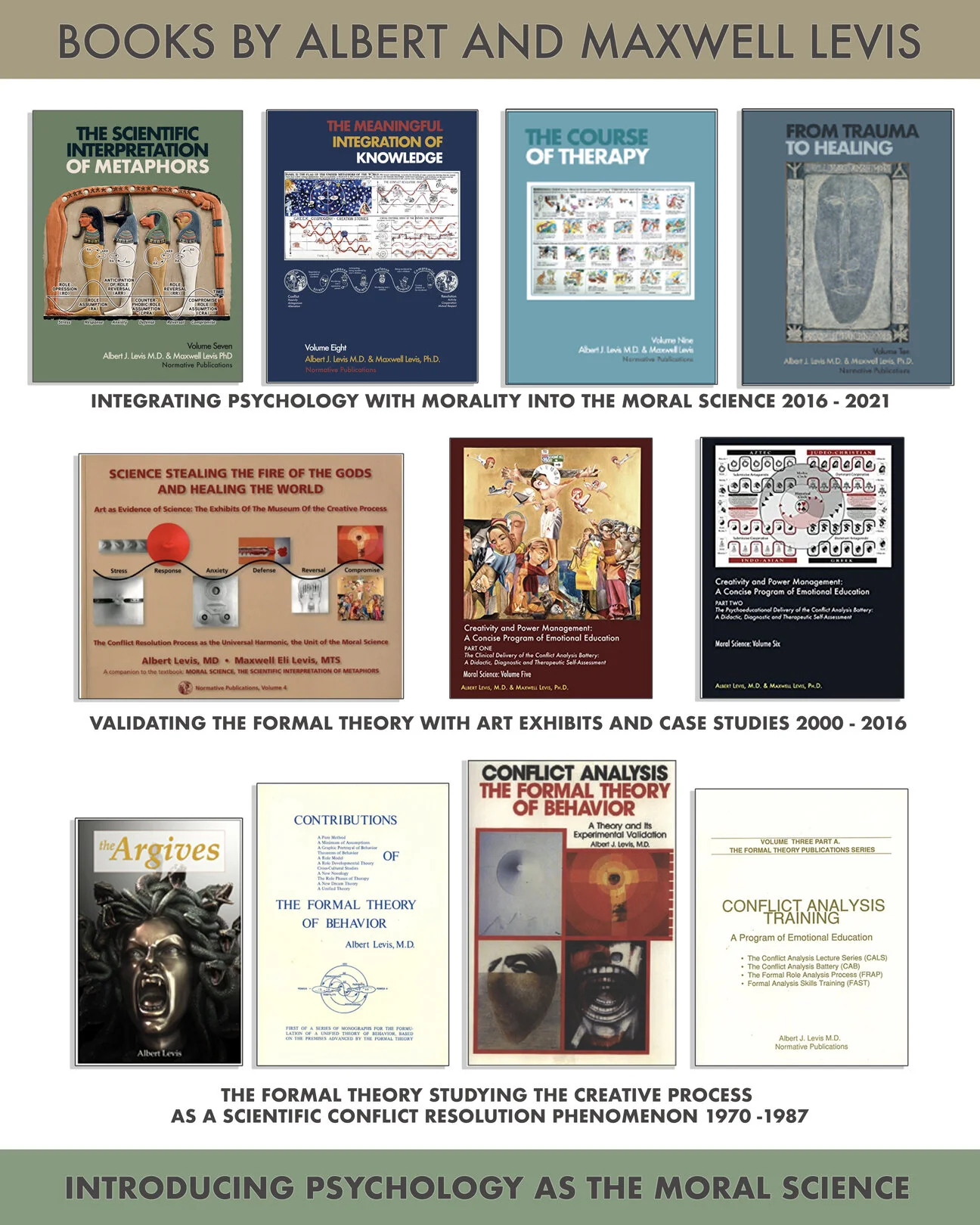Books by Albert Levis MD:
click on the book covers to check them out on Amazon.
Conflict Analysis Training
Conflict Analysis Training is a workbook of exercises and assessments that lead towards greater self awareness and understanding. The book guides its readers to an understanding of their relational modality, how they deal with conflict, and how they can best improve
Creativity & Power Management, A Concise Program of Emotional Education I: The Clinical Delivery of the Conflict Analysis Battery: A Didactic, Diagnostic and Therapeutic Self-Assessment, published in Spring 2016, is book of clinical case studies, illustrates a new theory, the Formal Theory, and a new therapy, Creativity and Power Management, as a concise program of emotional education utilizing the Conflict Analysis Battery and the simple scientific principles of the Formal Theory .
Science Stealing the Fire of the Gods, published Summer 2011, explores in detail the Museum’s exhibits, investigating the emotional discovery present in the Gorski Retrospective, and retracing the evolution of abstraction in religious paradigms. Based upon the myth of Prometheus stealing the fire of Olympus, the book presents science as now demystifying religion and offering humanity the tools of moral life.
Conflict Analysis: the Formal Theory of Behavior, outlines the principles of the Formal Theory, and develops a scientific method for understanding behavior. The textbook formulates a method of studying emotional energetic transformations with the guidance of physics, studying the dialectics of unconscious dynamics as a scientific phenomenon.
Creativity and Power Management, A Concise Program of Emotional Education II: The Psychoeducational Delivery of the Conflict Analysis Battery, published Fall 2016, is a book of case studies from clients that have completed the online emotional education program as well as cases from students and other-non clinical clients. The book presents a model of wellness education for the masses and a format for introducing emotional education to the classroom.
The Moral Science Primer: Psychology as the Science of Conflict Resolution
The Primer presents the premise's validation by identifying the six-emotions syndromal order and the four relational modalities examining samples of the creative process in three realms: First, the art exhibits of the Museum of the Creative Process; Second, case studies utilizing a creativity-generating self-assessment, and Third, examining religions as discoveries of the alternative ways of resolving conflicts. These validations confirm the unconscious as a measurable, graphically portrayable, conflict resolution entity that spiritualizes psychology, while demystifying religions.
The Moral Science Primer consists of four sections, each presenting one of the disciplines of psychology as illustrated by the four images displayed on the top of the book covers displayed below..
KIRKUS BOOK REVIEW
THE MORAL SCIENCE PRIMER Psychology as the Science of Conflict Resolution Albert Levis and Maxwell Levis
Albert and Maxwell Levis, father and son psychiatrists, reevaluate the scholarly foundations of their profession.
Born in Greece in 1937 to a Jewish family, co-author Albert Levis spent his childhood in hiding during the Holocaust and post-war communist uprising, which claimed the lives of his father, grandfather, and other “good people” of Athens’ Romaniote Jewish community. This childhood trauma and firsthand experience with the bloodiest conflict in human history would shape his life’s work as a research psychiatrist dedicated to morality and conflict resolution.
Following his residency at Yale University in the 1960s, Levis wrote, across nearly half a century, a series of books on what he calls the “Formal Theory of Behavior,” which is “based on observing the creative process, the plot of stories, reflecting the unconscious, as a scientific conflict resolution phenomenon.” From this foundation, the book explores a wide variety of creative works, from Greek mythology and Jewish scripture to 20th-century novels, as it analyzes humanity’s approaches to conflict resolution.
Co-written with his son, Maxwell Levis, an assistant professor of psychiatry at Dartmouth’s Geisel School of Medicine, this work offers a primer on the intersection of Levis’ Formal Theory with the scientific underpinnings of morality, human creativity, and conflict resolution. The volume is divided into four separate “books,” framed by a multi-chapter introduction and conclusion.
Book one explores the scientific structure of the creative process, interpreting metaphors in myth and creative writing (including a lengthy analysis of The Wizard of Oz).
Books two and three center on more pragmatic issues of diagnosis and therapeutic assessment, citing case studies that are then linked to the Oz narrative.
The book’s final section makes the case for “morality as a scientific phenomenon,” arguing that “the unconscious is measurable” and that there is a scientific foundation for human religions.
While emphasizing the value of religion, the book also cautions that these systems of belief “should be humbled in their self-righteousness presenting themselves as the total truth.”
The text’s dense, jargon-filled prose does not make for a leisurely read, and is not made easier by the multi-book structure, which leads to repetition across the four sections. Its generous selection of full-color illustrations, reproductions of classical artwork, and a plethora of charts and diagrams, however, break up the book’s occasional monotony.
As an interdisciplinary work that focuses not only on the human mind but on history, literature, and religion, the book may appeal to a wide range of scholars, including anthropologists, literary critics, and psychologists. On the other hand, it risks overselling its status as a “groundbreaking” and “significant contribution” to “the field of social sciences,” given its relatively brief bibliography that heavily cites the Levis’ previous work and only a handful of studies published after 2010.
Though not all readers will be convinced by its lofty claims, the book does make a convincing case asserting that the current therapist/patient paradigm, guided by “medicalization and agnosticism,” would be well-served by new approaches. And while its extensive analysis of The Wizard of Oz works within the framework of its overall argument, that early-20th century work’s central role in the text may not resonate with 21st-century readers.
A thoughtful and humane, if prolix, reevaluation of human morality and the creative process.






